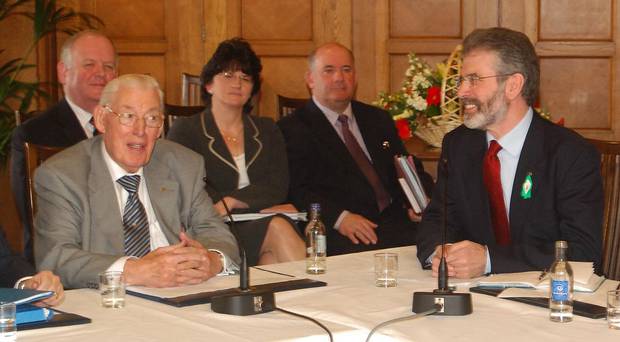Photo credit: Belfast Telegraph
1 – Gerry Adams & Ian Paisley Meet Face-to-Face Over a Power-Sharing Government in Northern Ireland
Northern Ireland’s main political parties agreed to start sharing power on 8 May 2007 after a historic deal was brokered by the DUP’s Rev Ian Paisley and Sinn Féin’s Gerry Adams at Stormont on 26 March 2007.
The date was confirmed by Rev Paisley after the first face-to-face meeting between the leaders of the Democratic Unionist Party and Sinn Féin, which lasted an hour, in Stormont’s Parliament Buildings.
They agreed that between the day of the meeting and 8 May, when the devolved government would be restored, the Assembly parties would be involved in preparatory work to ensure that the powersharing ministers would be able to hit the ground running.
The agreement included the provision for regular meetings between Rev. Paisley and Sinn Féin’s Martin McGuinness as the de facto First and Deputy First Ministers.
The crucial meeting saw delegations from the DUP and Sinn Féin hammer out the final agreement for a return to power-sharing.
Following the agreement, Ian Paisley and Gerry Adams, sat side by side (as seen above) for their first news conference in Stormont, confirmed that power-sharing would begin on 8 May.
The devolved government of Northern Ireland, an administrative branch of the legislature Northern Ireland Assembly, was established according to the terms of the Northern Ireland Act 1998, which followed the historic Good Friday Agreement.
2 – The Virginia Tech Shooting
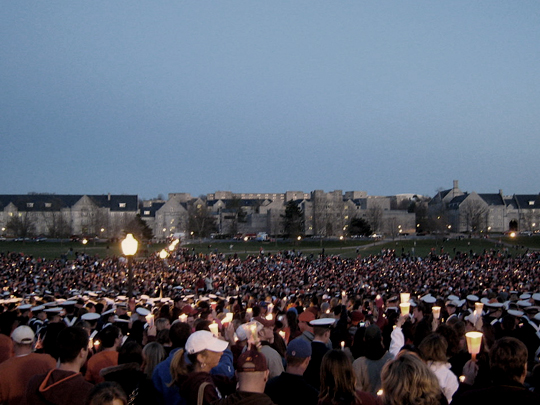
The Virginia Tech shooting was a school shooting that took place on 16 April 2007, in Blacksburg, Virginia. It is the deadliest school shooting in U.S. history.
Seung-Hui Cho, an undergraduate student at the university, killed 32 people and wounded 17 others on the campus with two semi-automatic pistols. Six other students were injured jumping from windows to escape the shooting.
As law enforcement closed in on his location, Cho shot himself in the head with a pistol, dying instantly.
At the time it was the deadliest mass shooting committed by a lone gunman in U.S. history, though it has sadly since been surpassed by mass shootings at an Orlando nightclub and another at an outdoor music festival in Las Vegas.
Cho had previously been diagnosed with a severe anxiety disorder and received therapy and special education support.
However, due to federal privacy laws, Virginia Tech was unaware of Cho’s previous diagnosis or the support he had needed.
After being accused of stalking two female students in 2005, a Virginia special justice declared Cho mentally ill and ordered him to attend treatment. However, as he was not institutionalized, he was still allowed to purchase guns.
The shooting prompted the state of Virginia to close legal loopholes that had previously allowed mentally unsound individuals to purchase handguns without detection.
It also led to the passage of the first major federal gun control measure in the U.S. since 1994.
3 – Benazir Bhutto Assassinated
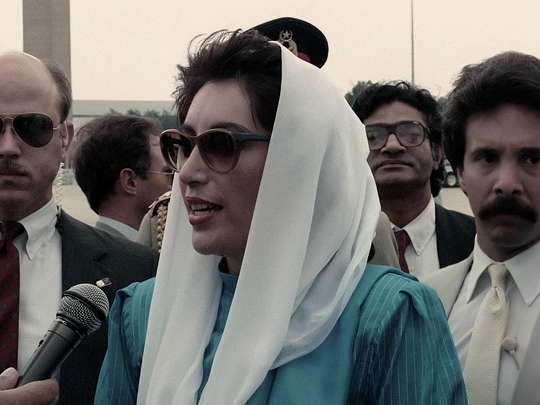
The assassination of Benazir Bhutto took place on 27 December 2007 in Rawalpindi, Pakistan.
Bhutto had twice been the Prime Minister of Pakistan and was the then-leader of the opposition, the Pakistan Peoples Party. She had been campaigning ahead of elections scheduled for January 2008.
Shots were fired at her after a political rally at Liaquat National Bagh, with a suicide bomb being detonated immediately after the shooting. Twenty-five people in total were killed by the bombing.
The Pakistani Interior Ministry initially stated that Bhutto died of a skull fracture sustained when the explosion caused her head to strike the sunroof of the vehicle.
However, Bhutto’s aides rejected this narrative, insisting she had suffered two gunshots prior to the bomb exploding. The Interior Ministry subsequently backtracked from its previous claim.
Two months earlier, Bhutto had survived a similar attempt on her life that killed at least 180 people after her return from exile.
A United Nations investigation revealed that the assassination could have been prevented if adequate security measures had been taken.
Months earlier, Bhutto had unsuccessfully requested extra protection from foreign contracting agencies.
4 – The Saffron Revolution in Myanmar
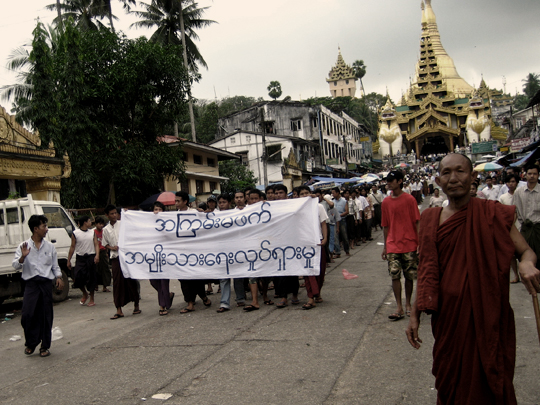
The Saffron Revolution was a series of economic and political protests and demonstrations that took place during August, September, and October 2007 in Myanmar.
The protests started after the national military government decided to remove subsidies on the sales prices of fuel.
The government is the only supplier of fuel, meaning the removal of the price subsidy caused prices to increase by up to 100% and the price of natural gas for buses increased by 500% in less than a week.
The protests were led by students, political activists, and Buddhist monks, taking the form of a campaign of nonviolent resistance. In response, dozens of protesters were arrested or detained.
Starting in September 2007 the protests were led by thousands of Buddhist monks, and those protests were allowed to proceed until a renewed government crackdown in late September 2007.
The exact number of casualties is not known but it is estimated up to 31 people died as a result of reprisals by the government, while several hundred people were also detained.
Nevertheless, Senior General Than Shwe remained in power until he retired in 2011 at age 78.
5 – Lewis “Scooter” Libby is found guilty of lying to FBI agents and to a Grand Jury
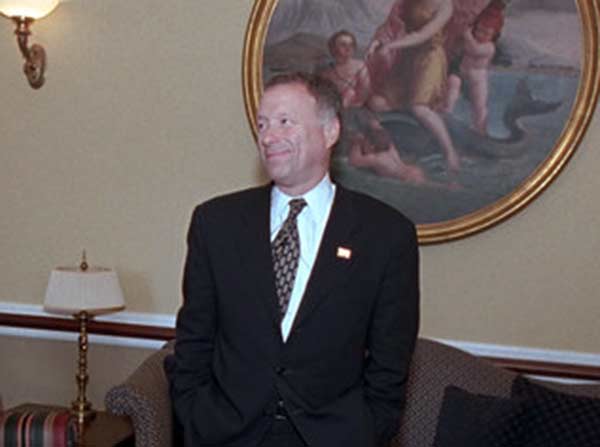
United States v. Libby was the federal trial of Lewis “Scooter” Libby, a former high-ranking official in the George W. Bush administration, for interfering with a criminal investigation by the special prosecutor.
Libby served as Assistant to the President under George W. Bush and Chief of Staff to the Vice President of the United States under Dick Cheney from 2001 to 2005.
Libby resigned from his government positions hours after his indictment on 28 October 2005.
A federal grand jury indicted Libby on five felony counts of making false statements to federal investigators, perjury for lying to a federal grand jury, and obstruction of justice for impeding the course of a federal grand jury investigation.
The investigation was concerned with the possibly illegal leaking by government officials of the classified identity of a covert agent of the CIA, Valerie Plame Wilson, the wife of former Ambassador Joseph C. Wilson IV.
On 6 March 2007, Libby was convicted on four counts of perjury, obstruction of justice, and making false statements. He was acquitted of one count of making false statements.
Libby was sentenced to 30 months in prison and fined $250,000. The sentence was commuted in June 2007 by President Bush, voiding the prison term.
In March 2008, Libby was disbarred by the District of Columbia Court of Appeals, in Washington, D.C., at least until 2012. Libby was readmitted to the D.C. bar in November 2016 after successfully petitioning the court for reinstatement.
As of 13 April 2018, the convictions no longer stand on the record after Libby was pardoned by President Donald Trump.
6 – The iPhone & Kindle are Released
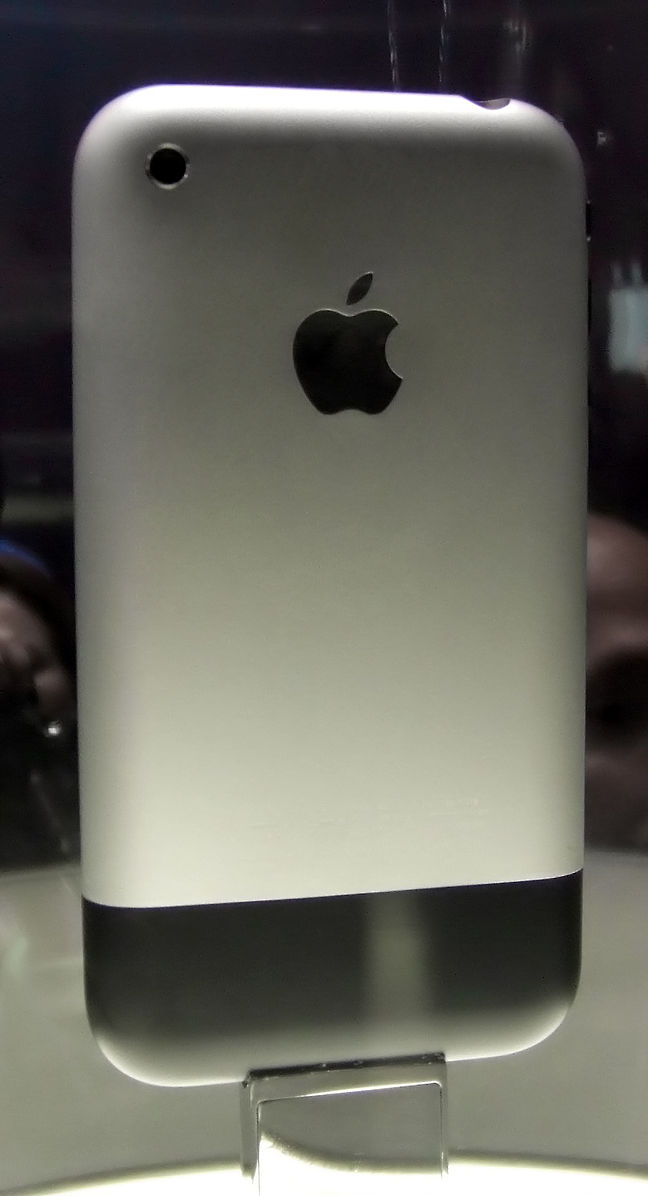
The first-generation iPhone was unveiled to the public by Steve Jobs on 9 January 2007, at the Macworld 2007 convention at the Moscone Center in San Francisco, prior to being released on 29 June 2007.
Development of the iPhone began in 2004 when Apple put a team of 1,000 employees (including designer Jonathan Ive) to work on the highly confidential “Project Purple.”
As of August 2017, a total of more than 1.2 billion iPhones had been sold around the world.
Meanwhile, in 2004, Amazon founder and CEO, Jeff Bezos instructed the company’s employees to build the world’s best e-reader before Amazon’s competitors could.
On 19 November 2007, Amazon released the Kindle, its first e-reader for US$399, which sold out in just five and a half hours.
As of March 2018, the Kindle store has over six million e-books available in the United States.


